Purdue University has unveiled fresh new football uniforms for the Boilermakers, blending classic elements with modern design for the 2024 season and beyond. This revamp marks a significant moment for the program, honoring its rich history while stepping into a new era under head coach Ryan Walters. The design process was a closely guarded secret, involving a tight-knit group of Purdue Athletics staff dedicated to creating a look that resonates with players, fans, and the university’s identity.
The team behind the new Purdue Uniforms included key figures like Coach Ryan Walters, Director of Football Creative Services Ryan Long, Associate Director of Equipment Kyle Gergely, and General Manager Noah Joseph, among others. Secrecy was paramount. According to Gergely, the details were kept so confidential that even family members were in the dark, highlighting the commitment to a surprise reveal. This meticulous approach underscores the importance of the uniforms to the Purdue brand and football program.
The unveiling of the new Purdue uniforms was strategically timed, notably before the launch of the EA Sports college football video game, ensuring the updated look would be accurately represented in the virtual world. This detail emphasizes the modern relevance of uniform design in college football, extending beyond the field and into popular culture.
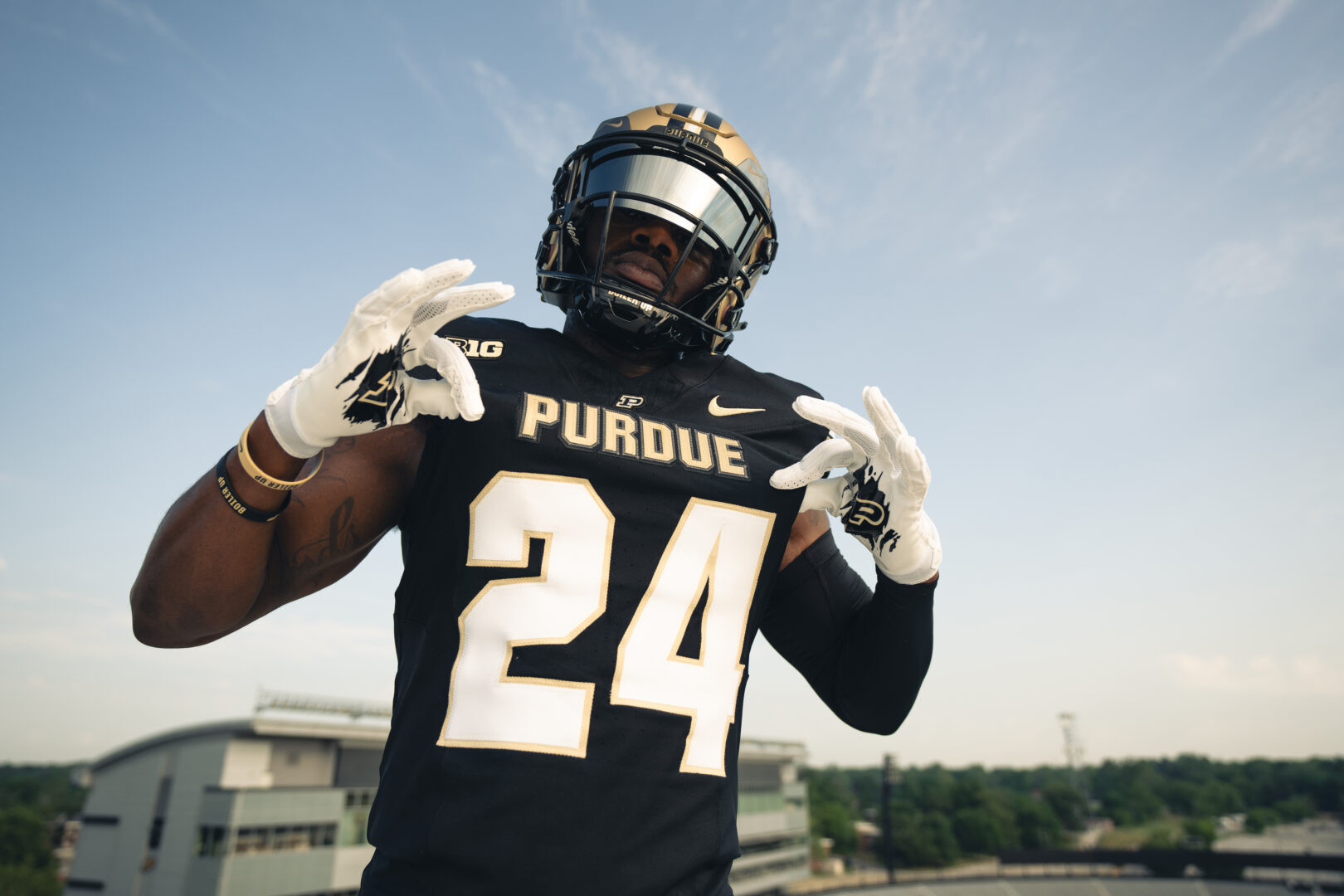 Image showcasing the new Purdue football uniforms from different angles, highlighting the jersey and pants.
Image showcasing the new Purdue football uniforms from different angles, highlighting the jersey and pants.
Fan reception to the new Purdue uniforms has been overwhelmingly positive, with praise for their clean, classic aesthetic that strongly represents Purdue’s iconic gold and black colors. Coach Walters emphasized staying true to Purdue’s established brand identity, a guiding principle in the design.
A key design element is the prominent “PURDUE” lettering across the chest of the jerseys. This harkens back to earlier eras, notably the 1990s when star fullback Mike Alstott wore jerseys featuring the university name. Ryan Long noted the historical significance of this choice, explaining that while the ‘P’ helmet logo is recognizable, explicitly spelling out “Purdue” on the jersey enhances brand recognition and immediately identifies the team. This direct branding approach aims to ensure that at a glance, there is no mistaking Purdue on the field.
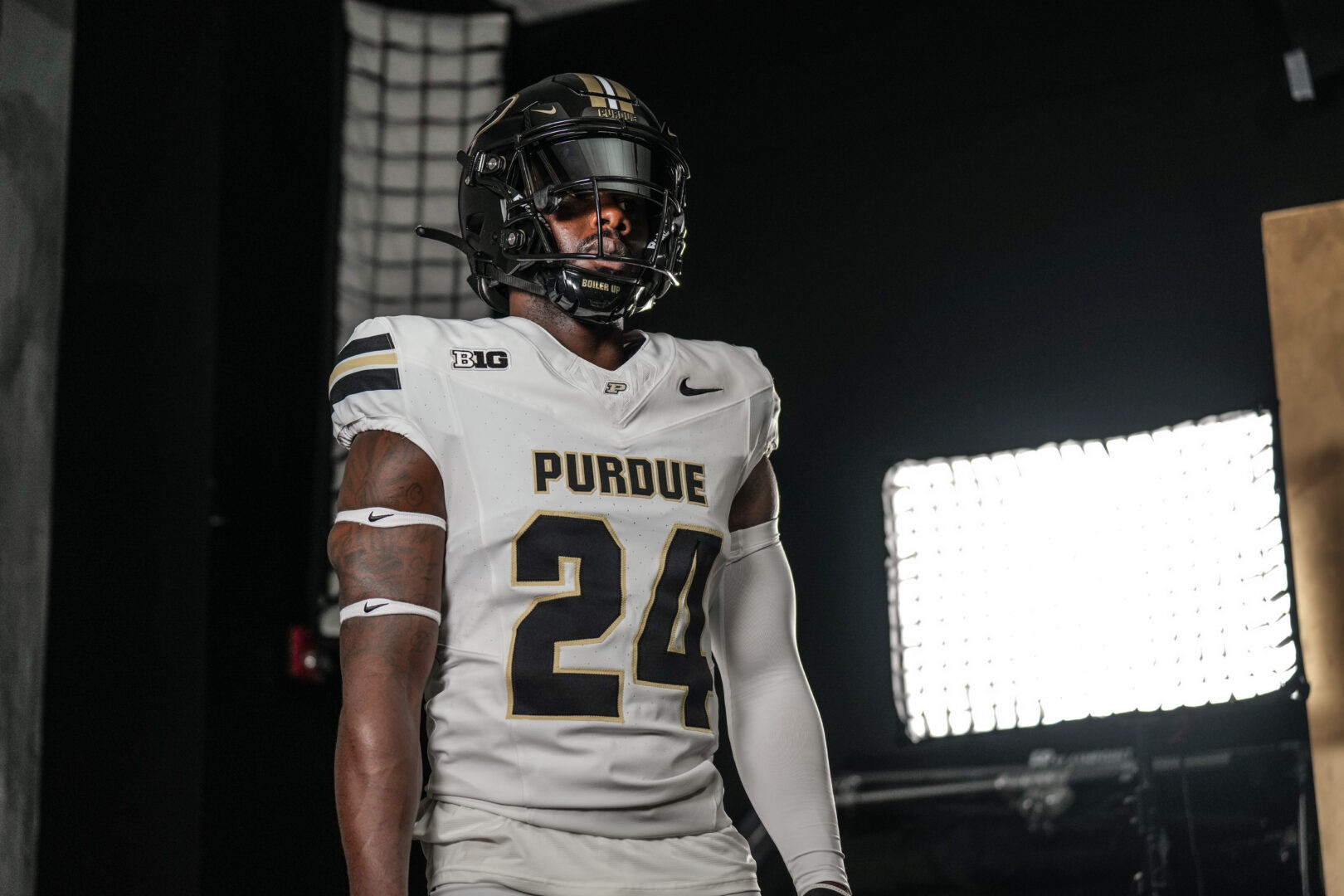 Close-up image of the new Purdue jersey, emphasizing the “PURDUE” lettering across the chest and the fabric detail.
Close-up image of the new Purdue jersey, emphasizing the “PURDUE” lettering across the chest and the fabric detail.
The design inspiration from the 1990s, particularly the Mike Alstott era, connects the new uniforms to a period of Purdue football tradition and success. Alstott, a program legend, embodies the toughness and grit associated with Boilermaker football. His success in the 90s, including setting records for rushing yards, provides a strong foundation for the new uniform design, linking the present team to a celebrated past.
 Image of Mike Alstott in a vintage Purdue uniform from the 1990s, illustrating the design inspiration for the current uniforms.
Image of Mike Alstott in a vintage Purdue uniform from the 1990s, illustrating the design inspiration for the current uniforms.
The uniform design process was thorough and detail-oriented, commencing almost two years prior to the unveiling. Ryan Long described the initial meetings where a variety of past Purdue jerseys and uniform elements were gathered for review. This hands-on approach allowed the design team to analyze historical details such as stripe styles, color patterns on different jersey types, and overall aesthetics that define “Purdue” football. Every detail, from stripe thickness to color shades, was carefully considered.
The result is a versatile uniform set featuring primary black and gold jerseys, complemented by black, gold, or white pants. This combination allows for visual variety while maintaining a consistent Purdue aesthetic. In addition to the standard uniforms, a special uniform is planned for the Oregon game on October 18th, including a unique helmet, adding an element of anticipation and special occasion flair to the season. Coach Walters’ vision was to establish strong, identifiable home and away looks for Purdue, ensuring brand consistency regardless of uniform combinations.
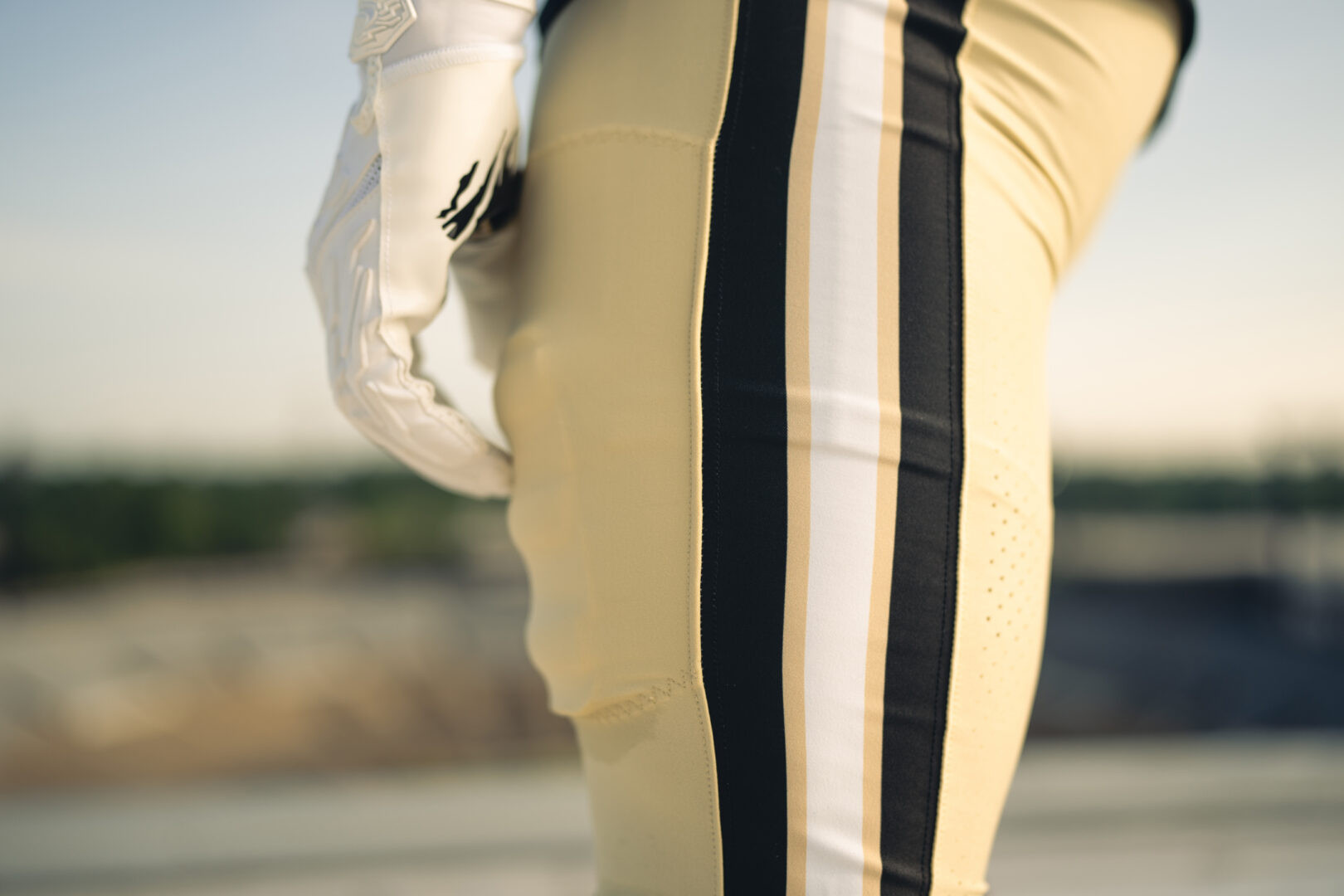 Image showcasing the different color combinations of the new Purdue uniforms, including black and gold jerseys with various pant options.
Image showcasing the different color combinations of the new Purdue uniforms, including black and gold jerseys with various pant options.
A Century of Purdue Football Uniform Evolution
Purdue football uniforms have undergone numerous transformations throughout the program’s history, reflecting evolving styles, technologies, and branding approaches. From the earliest days of the sport to the modern era, each decade has brought unique characteristics to the Boilermaker look.
1880s-1920s: The Early Years
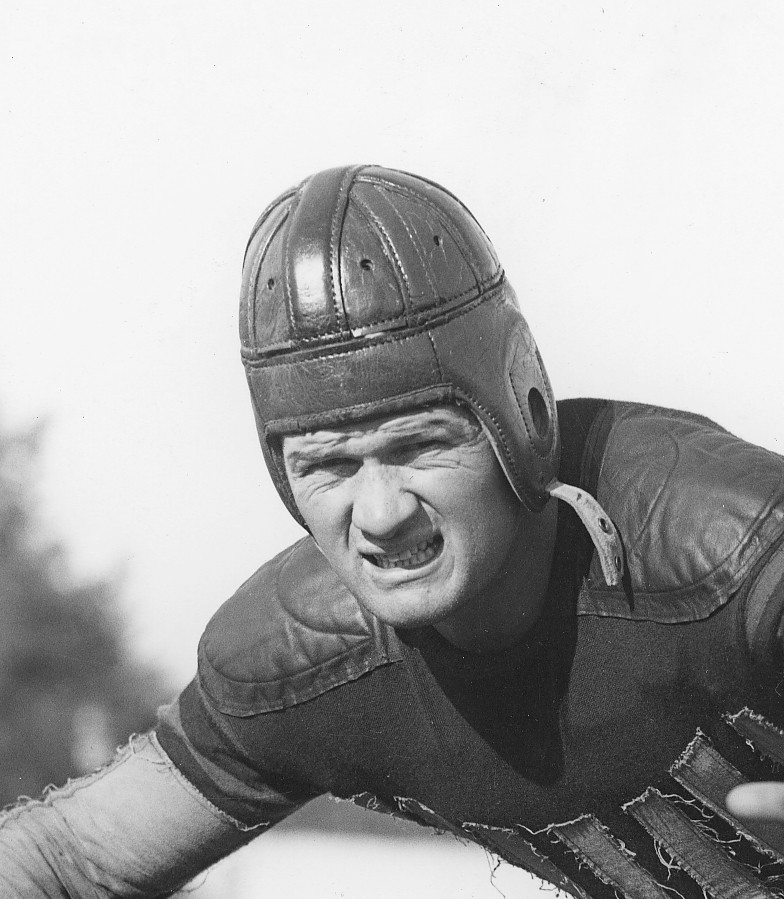 Historical image of Elmer Sleight, a Purdue football player from the 1920s, wearing an early football uniform with a leather helmet and stocking cap.
Historical image of Elmer Sleight, a Purdue football player from the 1920s, wearing an early football uniform with a leather helmet and stocking cap.
The formative years of Purdue football saw rudimentary equipment, including bulbous leather helmets without facemasks. Early uniforms featured stocking caps, loose-fitting pants, and jerseys with solid rectangular blocks and arm stripes. Notably, jerseys in the 1890s displayed a prominent “P,” marking an early effort in team branding.
1930s: Leather Helmets and Bold Numbers
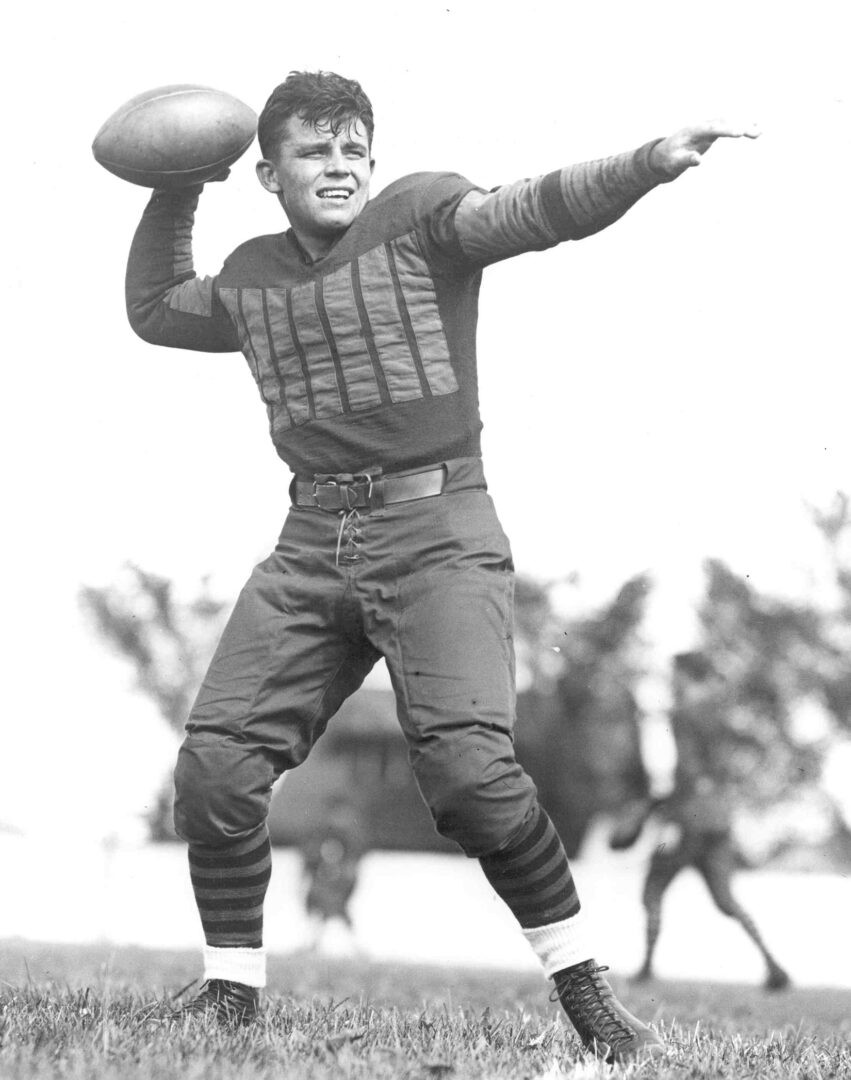 Historical image of Paul Pardonner, a Purdue quarterback from the 1930s, showcasing the winged leather helmet and solid black jersey with gold numbers.
Historical image of Paul Pardonner, a Purdue quarterback from the 1930s, showcasing the winged leather helmet and solid black jersey with gold numbers.
The 1930s introduced winged leather helmets, often adorned with a “P” on the forehead. Jerseys were primarily solid black with gold numbers, or variations with blocks and squares around the number. Pants remained loose-fitting, maintaining a classic football silhouette of the era.
1940s: Gold Pants and Winged Helmets
 Historical image of Alex Agase, a Purdue football player from the 1940s, wearing a uniform with shiny gold pants and a black helmet with gold wings.
Historical image of Alex Agase, a Purdue football player from the 1940s, wearing a uniform with shiny gold pants and a black helmet with gold wings.
Shiny gold pants became a signature element in the 1940s. Jerseys were simple, in white and black, with the white jerseys featuring distinctive stripes around the biceps. Black helmets with gold wings were a fashionable and popular design of the time, contributing to Purdue’s polished look during a successful period, including an undefeated 1943 season.
1950s: Conservative Designs and Striped Helmets
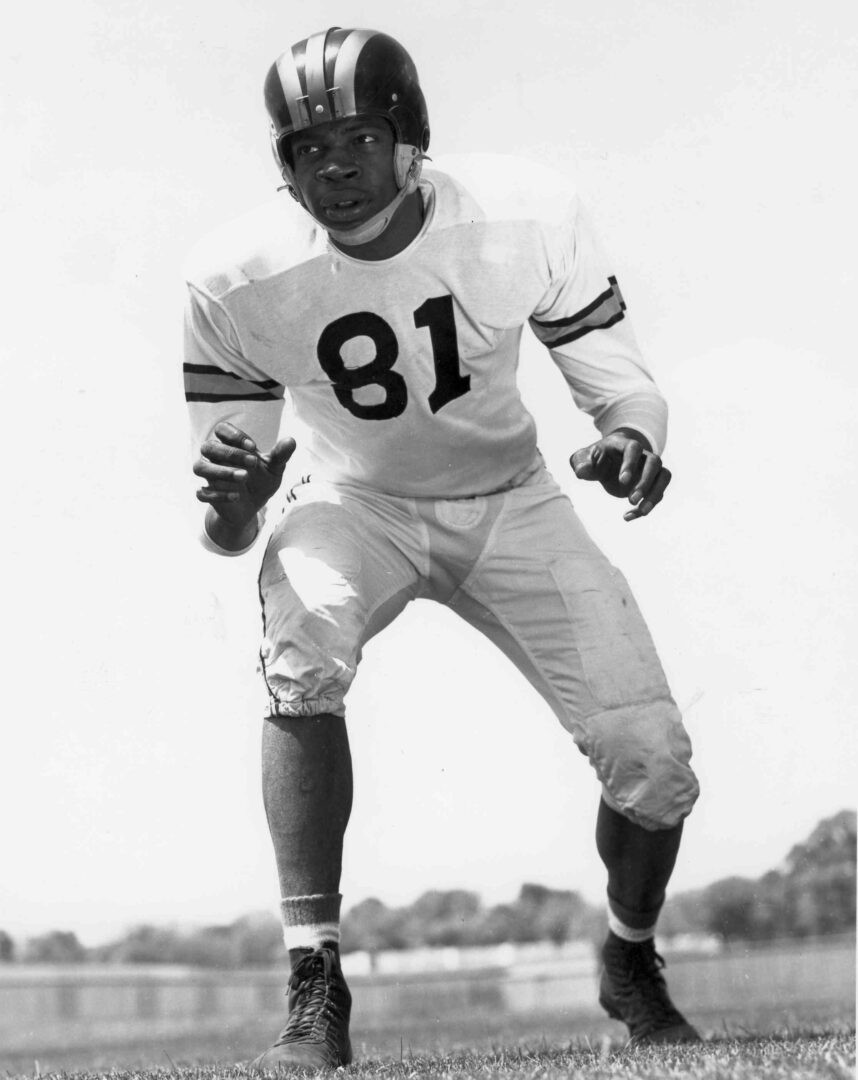 Historical image of Lamar Lundy, a Purdue football player from the 1950s, wearing a uniform with a striped helmet and armband detail on the jersey.
Historical image of Lamar Lundy, a Purdue football player from the 1950s, wearing a uniform with a striped helmet and armband detail on the jersey.
Reflecting the conservative trends of the 1950s, Purdue uniforms adopted a staid and practical approach. Pants were basic white, and jerseys, worn by players like Bernie Flowers and Lamar Lundy, were white or black with thin black-gold-black armbands. Helmets evolved from three stripes to a single stripe and then incorporated player numbers on the sides, a functional addition for player identification.
1960s: The Golden Era of Class and Simplicity
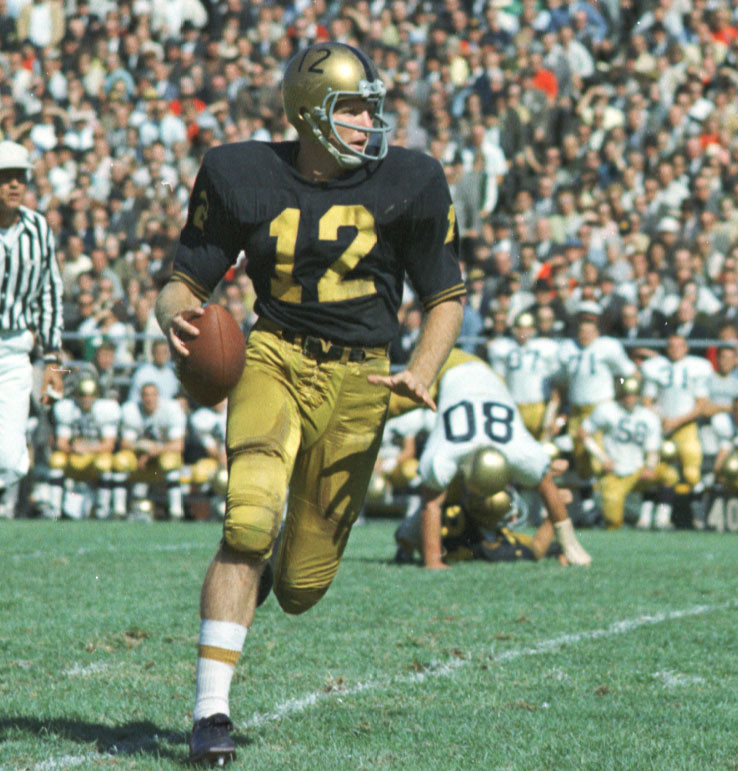 Historical image of Bob Griese, a Purdue quarterback from the 1960s, wearing a classic uniform with gold pants and a gold helmet with a black stripe.
Historical image of Bob Griese, a Purdue quarterback from the 1960s, wearing a classic uniform with gold pants and a gold helmet with a black stripe.
The 1960s, a dominant era for Purdue football led by figures like Bob Griese, featured classic and understated uniforms. Deep gold pants, black jerseys with a gold shoulder stripe, and gold helmets with a single black stripe defined this look. Player numbers were added to the sides of the helmets for clear identification, a practical yet stylish detail championed by coach Jack Mollenkopf. A centennial helmet in 1969 featured a special “P” logo, commemorating a university milestone.
 Image of the Purdue 1969 centennial helmet, featuring a special “P” logo incorporating “u” and “100”.
Image of the Purdue 1969 centennial helmet, featuring a special “P” logo incorporating “u” and “100”.
1970s: Block ‘P’ and Mesh Jerseys
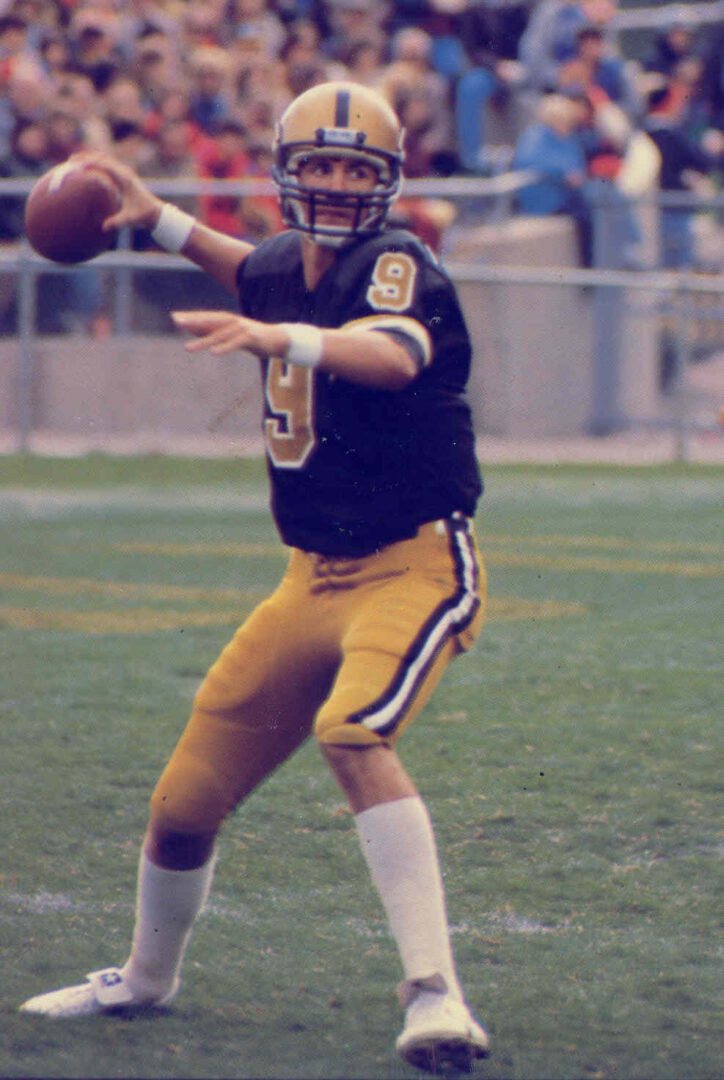 Historical image of Mark Herrmann, a Purdue quarterback from the 1970s, wearing a uniform with the block “P” helmet and mesh jersey.
Historical image of Mark Herrmann, a Purdue quarterback from the 1970s, wearing a uniform with the block “P” helmet and mesh jersey.
The 1970s brought the iconic block “P” helmet logo, which remains a Purdue symbol today. Helmets retained the black stripe and added player numbers to the back. Mesh jerseys and BIKE helmets became standard, reflecting advancements in athletic wear technology. Jerseys featured gold/white/gold stripes on the shoulders early in the decade, evolving to outlined designs later. Names on the back of jerseys were introduced for the first time, enhancing player recognition.
1980s: “PURDUE” on the Chest and Gold Jerseys
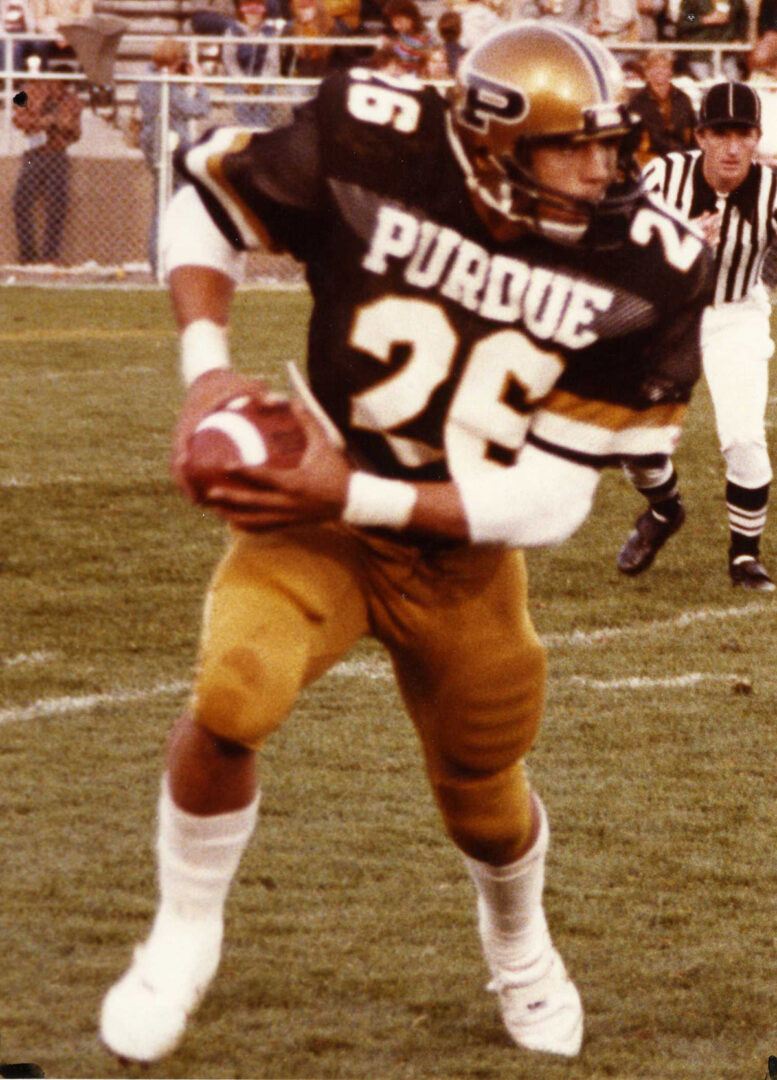 Historical image of Rod Woodson, a Purdue football player from the 1980s, wearing a gold jersey with “PURDUE” across the chest.
Historical image of Rod Woodson, a Purdue football player from the 1980s, wearing a gold jersey with “PURDUE” across the chest.
The 1980s saw the significant addition of “PURDUE” across the chest of the jerseys, improving brand visibility. A memorable moment included a surprise switch to gold jerseys for the 1986 Old Oaken Bucket game, dubbed the “Rod Woodson Game.” All-black home uniforms became more common, offering a striking alternative to traditional gold pants. Black helmets briefly reappeared at the end of the decade, marking a short-lived return to a past style.
1990s: Motion ‘P’ and Uniform Variety
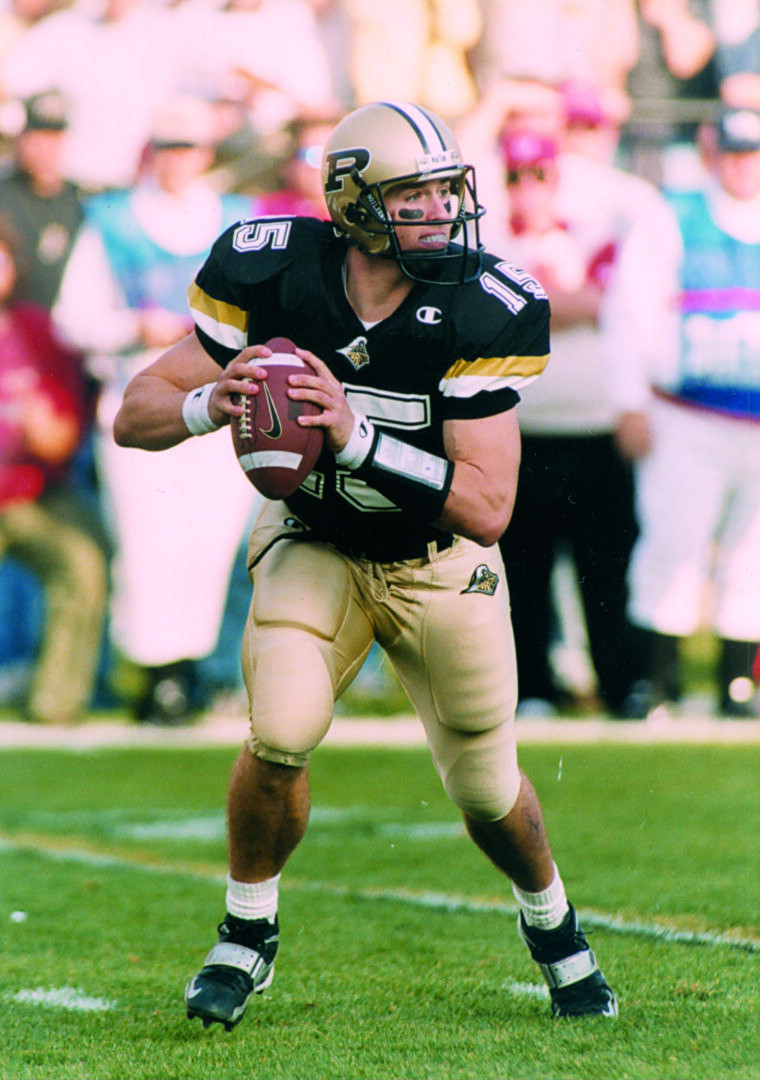 Historical image of Drew Brees, a Purdue quarterback from the 1990s, wearing a uniform with the motion “P” helmet and striped sleeves.
Historical image of Drew Brees, a Purdue quarterback from the 1990s, wearing a uniform with the motion “P” helmet and striped sleeves.
The 1990s introduced the motion “P” helmet logo, a dynamic symbol that endures. Under Coach Joe Tiller, Purdue uniforms underwent significant changes, moving away from “PURDUE” on the chest to striped sleeves and a train logo. “Old” gold was replaced by lighter “Vegas” gold, and numbers gained outlines for greater visual impact. This era marked a period of frequent uniform variations, aligning with a successful period for Purdue football.
2000s: Rose Bowl Patch and Alternate Colors
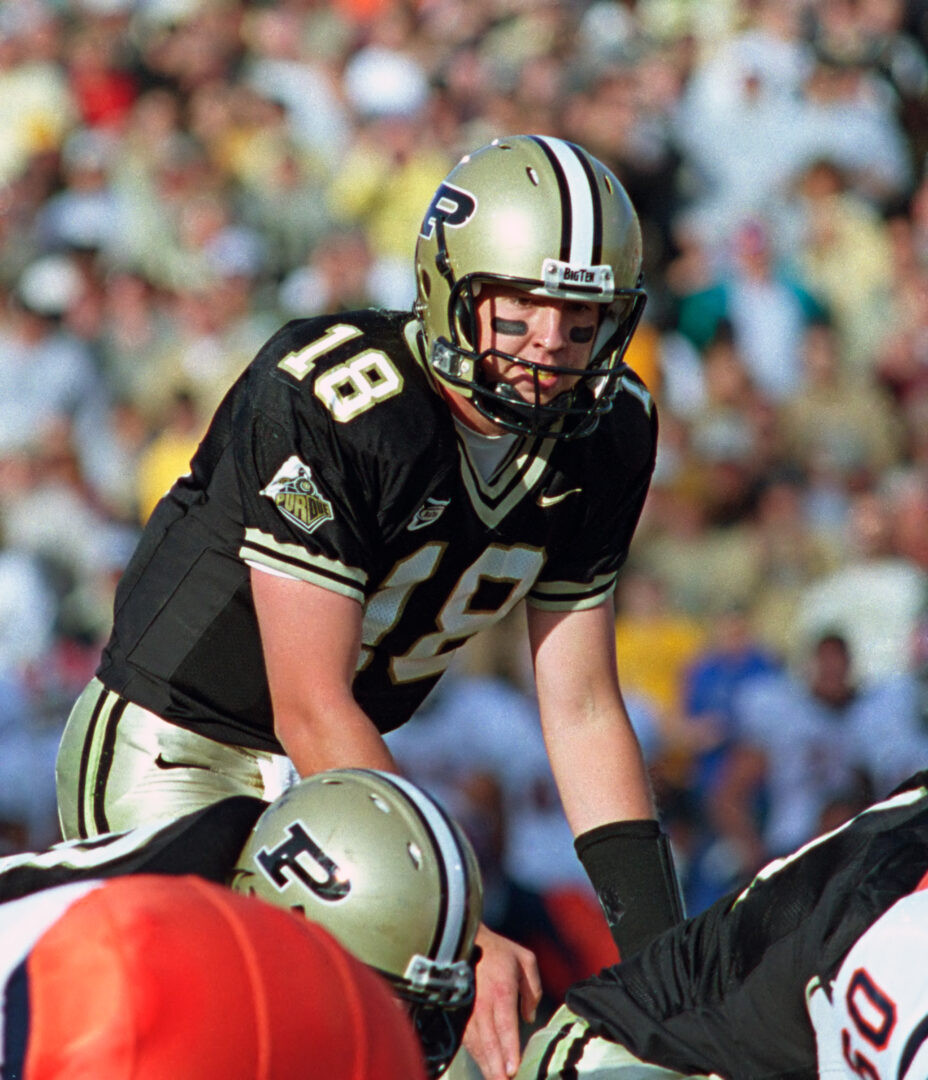 Historical image of Kyle Orton, a Purdue quarterback from the 2000s, wearing a uniform with a Rose Bowl patch on the helmet.
Historical image of Kyle Orton, a Purdue quarterback from the 2000s, wearing a uniform with a Rose Bowl patch on the helmet.
The 2000s began with a Rose Bowl appearance, commemorated by a rose patch on helmets. Following the 9/11 attacks, American flag patches were worn. Gold jerseys returned in 2002, followed by a reversion to black jerseys with train logos on the sleeves. Under Coach Danny Hope, all-black and all-white uniform combinations became frequent, adding further variety to Purdue’s on-field appearance.
2010s-Present: Modern Innovations and Throwbacks
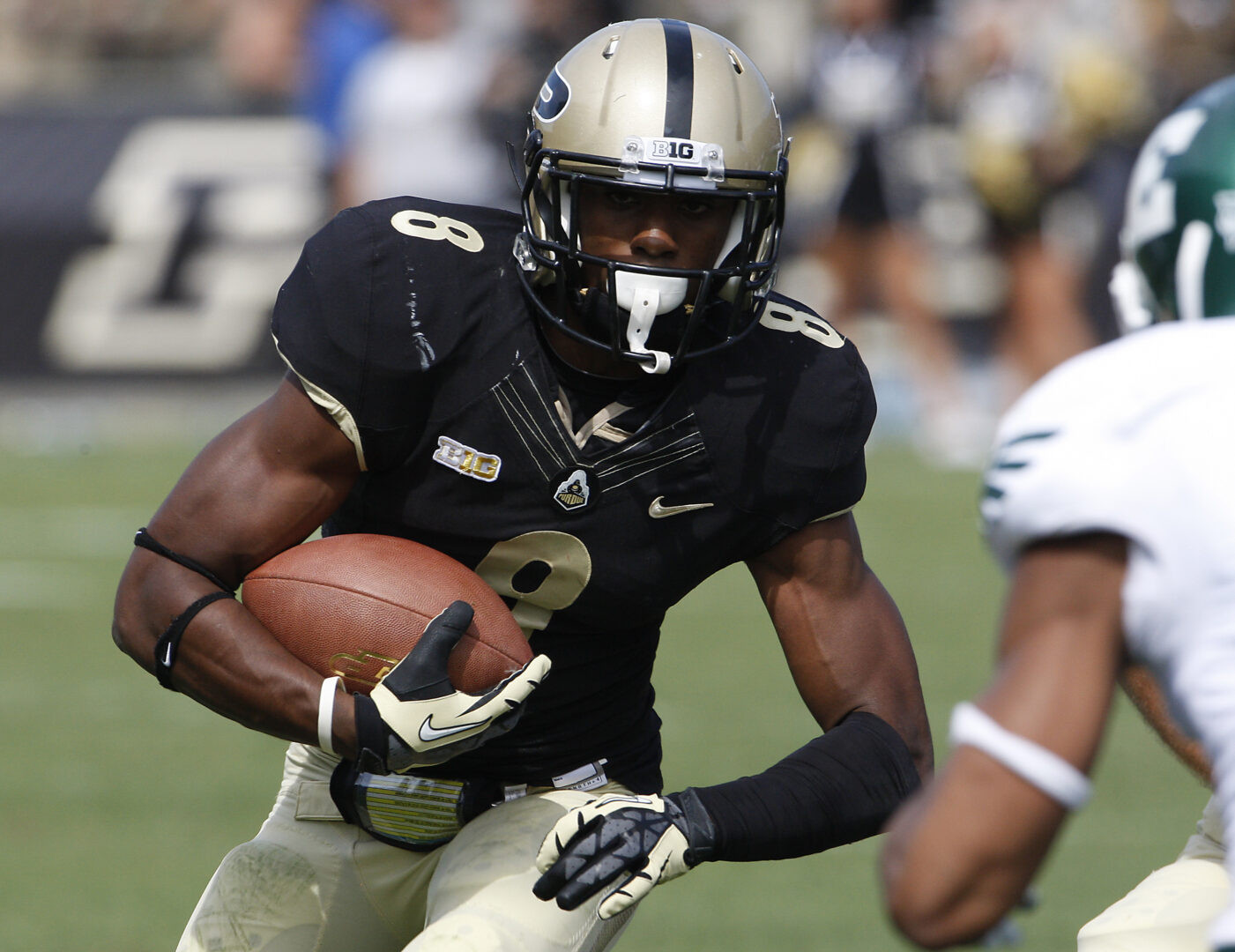 Historical image of Raheem Mostert, a Purdue football player from the 2010s, wearing a uniform with a train track stripe on the black helmet.
Historical image of Raheem Mostert, a Purdue football player from the 2010s, wearing a uniform with a train track stripe on the black helmet.
The 2010s saw the return of black helmets with a train track stripe, a nod to the Boilermaker Special. Unique designs included a helmet “P” made of fan photos and neon yellow accents to support cancer research. Gold chrome helmets were introduced under Coach Jeff Brohm, ushering in an era of diverse and innovative uniform designs. The astronaut-inspired all-white uniforms in 2019, celebrating Purdue’s “Cradle of Astronauts” legacy, gained widespread attention.
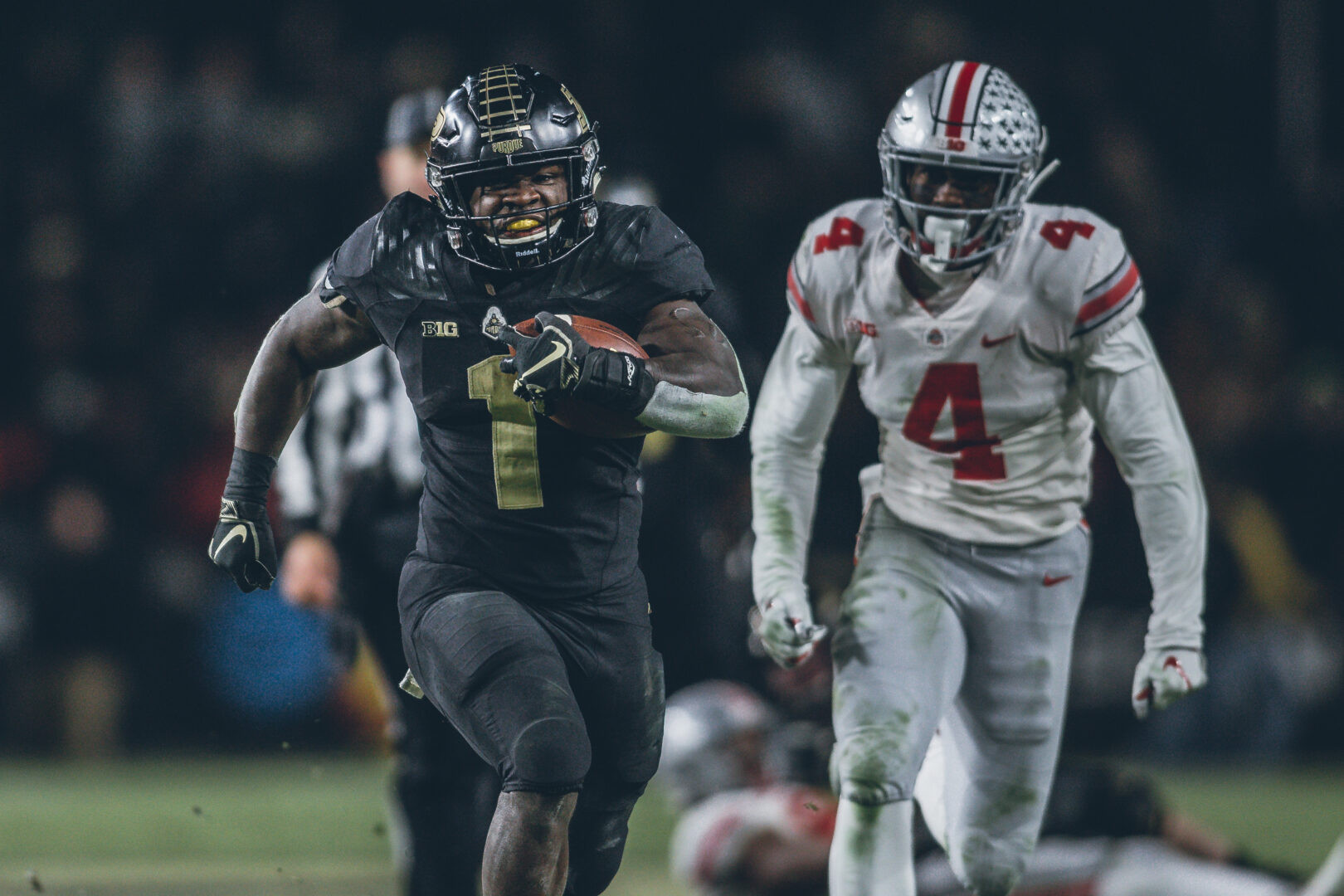 Image from a Purdue football game, showcasing the team in action in Ross-Ade Stadium.
Image from a Purdue football game, showcasing the team in action in Ross-Ade Stadium.
 Image of the Purdue 2019 astronaut-inspired uniforms, highlighting the unique design and chrome helmet stripe with footprints.
Image of the Purdue 2019 astronaut-inspired uniforms, highlighting the unique design and chrome helmet stripe with footprints.
The new Purdue uniforms under Coach Walters represent a thoughtful blend of Purdue’s rich uniform heritage with contemporary design principles. By incorporating elements from past successful eras and prioritizing brand identity, the Boilermakers are set to take the field in a look that is both timeless and distinctly Purdue.
To experience the new Purdue uniforms in person, fans can find limited single-game tickets for the 2024 season. Official jerseys are also available for purchase at the Purdue Team Store, allowing fans to show their Boilermaker pride in the latest style.
